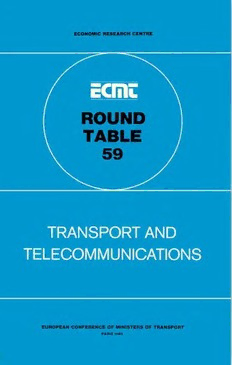
Transport and telecommunications. Report of the 59th Round table on transport economics, Paris, 14-15 January 1982 PDF
Preview Transport and telecommunications. Report of the 59th Round table on transport economics, Paris, 14-15 January 1982
ECONOMIC RESEARCH CENTRE TRANSPORT AND TELECOMMUNICATIONS EUROPEAN CONFERENCE OF MINISTERS OF TRANSPORT PARIS1983 ECONOMIC RESEARCH CENTRE REPORT OF THE FIFTY-NINTH ROUND TABLE ON TRANSPORT ECONOMICS Held in Paris on 14th-15th January,1982 on the following topic: TRANSPORT AND TELECOMMUNICATIONS EUROPEAN CONFERENCE OF MINISTERS OF TRANSPORT TheEuropeanConferenceofMinistersofTransport(ECMT)wasinstitutedbyaProtocol signedatBrusselson17thOctober1953.ItcomprisestheMinistersofTransportofthefollowing 19countries: Austria, Belgium, Denmark, Finland, France, Germany, Greece, Ireland, Italy. Luxemburg, Netherlands, Norway, Portugal, Spain, Sweden. Switzerland, Turkey, United Kingdomand Yugoslavia (associatedcountries: Australia, Canada, Japan, UnitedStates). ThepurposesoftheECMTare: - totakewhatevermeasuresmaybenecessarytoachieve,atgeneralorregionallevel,the maximum use and most rational development of European inland transport of internationalimportance: - toco-ordinateandpromotetheactivitiesofInternationalOrganisationsconcernedwith Europeaninlandtransport(rail,road,navigableways),takingintoaccounttheworkof supranationalauthoritiesinthisfield. Publicenfrancaissouslelitre: TRANSPORTSET TELECOMMUNICATIONS ©ECMT, 1983 ECMTpublicationsare marketed by theSaleofPublications Department oftheOCDE, 2, rue Andre-Pascal, 75775 PARIS CEDEX 16, France. TABLE OF. CONTENTS TRANSPORT AND TELECOMMUNICATIONS G. Claisse (cid:9) 5 SUMMARY OF THE DISCUSSION (Round Table debate on the report) . . . .(cid:9) 62 LIST OF PARTICIPANTS (cid:9) 91 ECMT ECONOMIC RESEARCH CENTRE Forthcoming publications (cid:9) 94 TRANSPORT AND TELECOMMUNICATIONS G. CLAISSE Laboratoire d'Economie des Transports Universite de Lyon II France SUMMARY I. INTRODUCTION (cid:9) 9 1. Telecommunications: a challenge for- ' transport (cid:9) . 9 2. Use's of telecommunications in the transport sector (cid:9) 10 II. COMMUNICATION TECHNOLOGIES IN THE ECONOMIC AND SOCIAL SYSTEM (cid:9) 12 1 . The growth process of demand for communica¬ tions media . (cid:9) 12 1.1. The development of information activities (cid:9)'. . 13 1.2. The needs imposed by the economic crisis .'(cid:9) .' . 13 2. The growth process of communications media . 15 2.1. Inventory of telecommunications media . 15 2.2. Inventory of prospective transport modes . (cid:9) 19 3. The. scope for transport/telecommunications substitution in relative terms (cid:9) (cid:9) 20 III. CONDITIONS FOR SUBSTITUTION (cid:9) 24 1 . Economic conditions (cid:9) .-.-(cid:9) 24 1.1. Comparative .costs (cid:9) 24 1.2. Comparative energy consumption (cid:9) 28 2. Fac'e-to-face/Interface: comparative effectiveness (cid:9) . . . (cid:9) 30 2.1. Electronic presence and physical presence (cid:9) .30 2.2. User behaviour with respect to- the' telephone (cid:9) 31 2.3. User attitudes to teleconferencing .... 31 2.4. Interface effectiveness as regards type of communication (cid:9) 32 IV. ASSESSING THE SCOPE FOR SUBSTITUTION (cid:9) 35 1 . Substitution for urban travel (cid:9) 35 1 .1 . Substitution for travel to and from workplaces (cid:9) 36 1.2. Substitution for urban travel (cid:9) 38 2. Substitution for intercity. travel (cid:9) 39 2.1. Assessments based on the demand for communication (cid:9) (cid:9) 39 2.2. Assessment of the scope for substitu¬ tion in the case of business trips ... 40 3. Substitution for mail (cid:9) 41 4. Assessment of the economic impact of substitution (cid:9) ; (cid:9) 42 4. 1 . Communication costs (cid:9) 42 4.2. Energy savings (cid:9) 44 5. Limitations of the studies (cid:9) 44 V. TRANSPORT, TELECOMMUNICATIONS AND LAND USE ... 47 1. Communication and location of firms (cid:9) 47 1.1. Communications networks and land-use . 48 1.2. Telecommunications and location of firms (cid:9) 49 2. Communication and urban organisation ...... 51 2.1. Remote work arid urban space (cid:9) 51 2.2. Impact of remote work on transport ... 52 2.3. Communications media and urban growth (cid:9) 54 VI. CONCLUSIONS (cid:9) 56 BIBLIOGRAPHY (cid:9) (cid:9) 58 I. INTRODUCTION, 1 . TELECOMMUNICATIONS: A CHALLENGE FOR TRANSPORT Transport and telecommunications are complementary technologies, essential to the functioning of the economic and social system, which facilitate the making and de¬ velopment of relationships. But as means of communica¬ tion they also compete. The recent development of tele¬ communications constitutes a challenge to the transport sector. This report sets out to identify the nature and scope of that challenge. Most studies of transport and telecommunications have been based on economic policy considerations, their purpose being to calculate how far developing the new telecommunications technologies would encourage alterna¬ tive policies for three structural problems facing developed societies: - transport congestion, and its effects on the urban environment; - the energy crisis; - land-use planning, and especially urban planning. These concerns, with which we shall be dealing later oh, have prompted researchers to think in terms of sub¬ stituting telecommunications for transport, .in order to assess the consequent reduction in the demand for trans¬ port. However, while substitution may be one of the challenges from the development of telecommunications, it is by no means the only one. We can distinguish four ways in which telecommunications can affect transport: - control: transport undertakings are using tele¬ communications to manage their vehicle stocks, control air, road and rail traffic and to manage transport demand; - substitution: telecommunications can be used instead of certain kinds of trip for communication purposes; - induced demand: the growth of telecommunications, generating additional communication needs, may lead to new trips;
